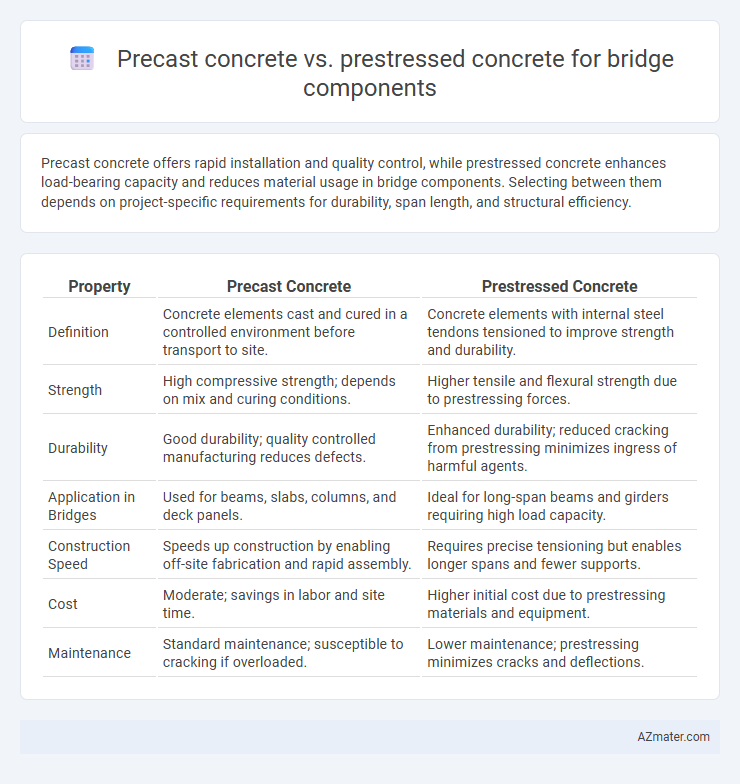Precast concrete offers rapid installation and quality control, while prestressed concrete enhances load-bearing capacity and reduces material usage in bridge components. Selecting between them depends on project-specific requirements for durability, span length, and structural efficiency.
Table of Comparison
| Property | Precast Concrete | Prestressed Concrete |
|---|---|---|
| Definition | Concrete elements cast and cured in a controlled environment before transport to site. | Concrete elements with internal steel tendons tensioned to improve strength and durability. |
| Strength | High compressive strength; depends on mix and curing conditions. | Higher tensile and flexural strength due to prestressing forces. |
| Durability | Good durability; quality controlled manufacturing reduces defects. | Enhanced durability; reduced cracking from prestressing minimizes ingress of harmful agents. |
| Application in Bridges | Used for beams, slabs, columns, and deck panels. | Ideal for long-span beams and girders requiring high load capacity. |
| Construction Speed | Speeds up construction by enabling off-site fabrication and rapid assembly. | Requires precise tensioning but enables longer spans and fewer supports. |
| Cost | Moderate; savings in labor and site time. | Higher initial cost due to prestressing materials and equipment. |
| Maintenance | Standard maintenance; susceptible to cracking if overloaded. | Lower maintenance; prestressing minimizes cracks and deflections. |
Introduction to Precast and Prestressed Concrete
Precast concrete involves casting concrete elements in a controlled factory environment before transporting them to the construction site, ensuring high quality and uniformity for bridge components. Prestressed concrete is a specialized form of precast concrete where steel tendons are tensioned before or after casting, providing enhanced strength and durability to withstand heavy loads and long spans. This combination improves construction efficiency, reduces site labor, and extends the lifespan of bridges through superior structural performance.
Key Differences Between Precast and Prestressed Concrete
Precast concrete components are manufactured off-site and rely on their mass and reinforcement for strength, while prestressed concrete incorporates tensioned steel tendons to actively counteract tensile stresses, enhancing load-bearing capacity. Precast concrete offers faster installation due to ready-made elements, whereas prestressed concrete provides superior durability and allows for longer spans with reduced material usage. The key differences highlight prestressed concrete's efficiency in tension management and structural performance compared to traditional precast methods.
Manufacturing Process Comparison
Precast concrete bridge components are manufactured by casting concrete into reusable molds at a controlled factory environment, allowing for high quality and dimensional accuracy. Prestressed concrete involves tensioning high-strength steel strands or wires before or after casting to improve load-bearing capacity and reduce cracking, which requires specialized equipment and precise tensioning techniques. The manufacturing process of prestressed concrete is more complex and capital-intensive compared to conventional precast methods, enabling longer spans and enhanced structural performance in bridge applications.
Structural Performance and Load-Bearing Capacity
Precast concrete offers high durability and uniform quality, making it suitable for repetitive bridge components with efficient construction times. Prestressed concrete significantly enhances structural performance by inducing compressive stresses that counteract tensile forces, greatly increasing load-bearing capacity and reducing cracking under heavy loads. The choice depends on bridge design requirements, where prestressed components provide superior strength for longer spans and higher load demands compared to traditional precast elements.
Durability and Longevity in Bridge Applications
Precast concrete offers high durability in bridge components due to controlled factory conditions ensuring uniform quality and reduced permeability, which minimizes corrosion risks. Prestressed concrete enhances longevity by introducing internal compressive stresses that counteract tensile forces, significantly reducing cracking and extending service life under heavy traffic and environmental loads. Both methods improve bridge resilience, but prestressed concrete typically provides superior performance in long-span applications where durability against dynamic stresses is critical.
Installation and Construction Efficiency
Precast concrete bridge components accelerate installation by allowing off-site fabrication and rapid on-site assembly, significantly reducing construction time and traffic disruptions. Prestressed concrete enhances construction efficiency through its ability to span longer distances with fewer supports, minimizing formwork and falsework requirements. Combining precast techniques with prestressed elements optimizes load-bearing capacity and installation speed, leading to cost-effective and durable bridge construction.
Cost Analysis: Precast vs Prestressed Components
Cost analysis of precast versus prestressed concrete bridge components reveals that precast elements generally offer lower upfront manufacturing and installation expenses due to simpler fabrication and reduced material requirements. Prestressed concrete, while involving higher initial costs owing to the tensioning process and specialized equipment, provides long-term economic benefits through enhanced durability, reduced maintenance, and greater load-bearing capacity. Selecting between precast and prestressed components depends on project-specific factors such as span length, structural demands, and life-cycle cost considerations.
Design Flexibility and Customization
Precast concrete offers extensive design flexibility with its ability to be cast into various shapes and sizes, accommodating complex architectural and structural requirements for bridge components. Prestressed concrete enhances customization primarily through control of tensioning forces, optimizing strength and span capabilities for specific load conditions. Combining both methods allows engineers to tailor bridge elements for improved durability, weight reduction, and aesthetic appeal in diverse construction scenarios.
Typical Bridge Components Using Precast and Prestressed Concrete
Typical bridge components using precast concrete include beams, deck slabs, wall panels, and barrier walls, offering rapid installation and consistent quality. Prestressed concrete is predominantly used in girders, box beams, and continuous spans to achieve higher load capacity and longer spans while reducing material usage. Combining precast and prestressed techniques enhances durability and structural efficiency in bridge construction projects.
Choosing the Right Solution for Bridge Projects
Precast concrete offers modular construction advantages with reduced site labor and enhanced quality control, making it suitable for repetitive bridge elements like beams and decks. Prestressed concrete provides superior load-bearing capacity and longer spans by applying compressive stresses to counteract tensile forces, ideal for bridges requiring high strength and durability. Selecting between precast and prestressed concrete depends on project-specific factors such as span length, load requirements, construction speed, and budget constraints to optimize performance and cost-efficiency.

Infographic: Precast concrete vs Prestressed concrete for Bridge component
 azmater.com
azmater.com